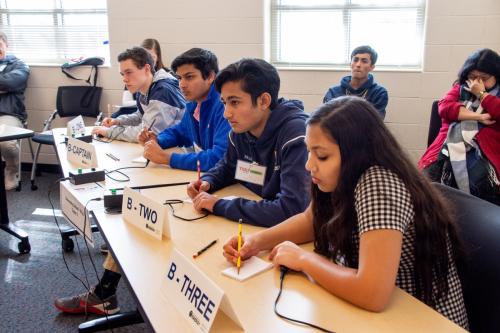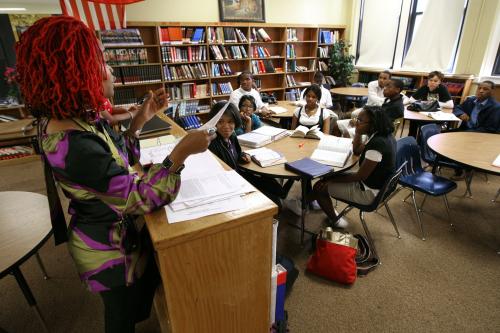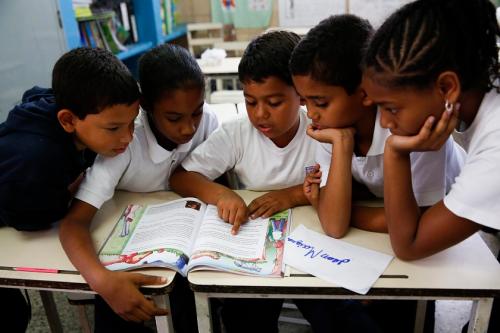It is no secret that America has deep political and economic challenges, despite the decadelong expansion since the end of the Great Recession. Politically, the country has split into red and blue tribes, but members on both sides are finding it increasingly impossible to talk with each other. Economically, although the economy’s expansion is in its ninth year, the prospects for upward mobility—earning more than your parents, as one measure—have diminished markedly over several decades, due to the widening of income and wealth inequalities not seen since before the Great Depression. The result is anxiety, anger, and incivility that has infected our politics and our lives.
Political leaders, academic and think tank scholars, journalists, and pundits across the political spectrum have offered all sorts of remedies for these political and economic ills. I have a very different prescription, not only to begin to heal our political and economic rifts, but to improve American education and students’ interest in learning: Require all students in high school, or earlier, to take one semester of debate, and ideally incorporate debate into humanities and possibly some science classes as well.
Healing a divided America with debate
I know it’s unconventional and possibly counterintuitive, what with all the partisan shouting matches we see on cable TV or (if you can bear them) in congressional floor speeches. But those are not the skills taught by competitive debating in school, namely how to: research; think critically and do it on your feet; back up arguments with evidence (not fake news!); work collaboratively with partners; speak persuasively in a civil fashion; and, perhaps most importantly, being able to argue both sides of most any issue or subject. These are also precisely the skills that all students, not just the less than 1 percent who participate in competitive debate, should acquire to be good citizens and to be successful in the workforce.
One county in America, Broward County in Florida, recognized this to be the case in 2013, when it became the first and only county—so far—to require all high schools, middle schools, and even elementary schools (beginning with fourth grade), to offer speech and debate classes. After getting off to a slow start, this “Broward Initiative” is now thriving, with over 12,000 students currently participating. The county proudly touts how its debate initiative is improving educational performance of its student-participants.
It should be no surprise, therefore, that two of the leaders of movement for gun control who emerged after the February 2018 mass shooting at Marjory Stoneman Douglas High School in Broward County, David Hogg and Jaclyn Corin, debated competitively. Several other students from the school had been preparing for debates over gun control before the tragic shooting took place.
Hundreds of thousands of former competitive debaters know the value of debate from their own experiences. Nonetheless, the fact that many successful politicians, actors, and business leaders were once debaters doesn’t prove that debate made a difference in their lives; many of them may have been predisposed to be good researchers and speakers, and that’s why they enrolled in debate. This may have been true for some, but also somewhat beside point. Even the most naturally gifted people can and do benefit from formal instruction in any activity, practice and hard work. Just ask Michael Jordan, Serena Williams, or Bryce Harper, or any other highly successful athlete.
In my own case, “selection bias” clearly wasn’t an issue. Until the age of 15, I had a severe stutter, and my mother (on the suggestion of a friend) had to more than twist my arm to persuade me to enroll in a speech and debate class in my sophomore year in high school. Thank goodness she did. Competitive debate not only cured the stutter that up to that point made me reluctant to speak up in class—and which years of formal speech therapy was unable to fix—but it also taught me research and thinking habits and gave me confidence to succeed in school, opening the door to a successful professional career thereafter.
In any event, controlling for selection bias has become essential in social science to prove that any kind of educational or policy intervention “works” or adds value—and thus to convince policymakers, educators, or school boards to implement a new idea. Removing selection bias is relatively easy for policy interventions that can be randomized, like clinical trials of drug discoveries, and the results from one group, randomly chosen, that gets the “treatment” compared to a control group that does not. Randomized control trials have not yet been used for competitive debate so far, however, because schools understandably have let any student who wants to enroll in a speech and debate class in high school (or earlier) to do so.
An alternative statistical technique for controlling for selection bias is to use multiple regression analysis to separate out the contributions of different possible variables, including a variable designed to test for selection bias, to the performance of a dependent variable, like educational performance. In the debate context, one study published in 2011 by Professor Briana Mezuk, an epidemiologist at the University of Michigan (then at Virginia Commonwealth University) and three co-authors, has done this. It compared the educational performance of debaters and non-debaters in the Chicago Public School district at the same schools that participated in the Chicago Urban Debate League—a national competitive debate network for mostly minority students—from 1997 through 2006. The authors controlled for self-selection by calculating a debate propensity score based on eighth grade standardized test scores. They find that even after accounting for the influence of self-selection, debaters were “more likely to graduate from high school, performed better on the ACT, and showed greater gains in cumulative GPA relative to similar comparison students.”
At the very least, the Chicago study—coupled with the anecdotal evidence I have learned in interviews for a book I am doing on this topic—suggests that more students should be encouraged to participate in competitive debate purely for educational reasons, as Broward county has done. One noteworthy activity is the Matthew Ornstein Summer Debate Institute, held in Washington, D.C., which provides debate training for minority students as early as sixth grade. Started several years ago with just 30 campers, last summer the program hosted over 150, and is getting stronger and more influential every year.
The case for debate-centered instruction
I believe there is a case for doing even more without putting every student through the rigors of competitive debate—which admittedly is not for everyone—even in school districts like Broward County that have made the activity much more popular. That idea is to “debatify” (a term coined by Les Lynn, featured shortly below) other parts of high school and lower school curriculum and classes. By that, I mean structure at least some of these classes around student debates on key questions raised by their literature, history, civics, and even science classes.
Students are much more likely to remember what they researched and debated than some or even much of the material that is delivered to them in lecture format and then regurgitated on an exam. It is often said that the best way to learn something is to teach. Debate-centered education takes this adage up a notch, requiring students not only to teach, but also to be persuasive on both sides, requiring anticipation of questions and counter-arguments, activities that teacher-delivered lectures do not promote.
As Professor Mark Roche, the former dean of arts and sciences at Notre Dame, has written, famous scholar-educators through the years—notably Socrates and Rousseau—have recognized that students learn more when they are “actively engaged in the learning process (instead of simply receiving answers).”1 Debate is perhaps the purest form of “active learning” one can imagine.
Moreover, it is a good way to engage students in the fun of learning, especially for those who are bored or may be a grade level or two behind where they should be. Educator Lucy Crehan—whose book, “Cleverlands,” provides an authoritative survey of why school systems in other countries are out-performing ours—observes that the “motivation of students plays a huge part in whether they succeed.”2 Having to prepare for and participate in a debate in class, perhaps first in small groups and later before the entire class, should be an ideal way to motivate students who are at an age where they want to express themselves. Structured debate formats make that possible, through civil discourse, and should make learning enjoyable and worth pursuing.
Widespread exposure to and participation in debate-centered education could also make students who go on to college more willing to tolerate others’ points of view, and also to be more tolerant themselves, issues which have been highlighted by a number of authors, most recently by Greg Lukianoff and Jonathan Haidt in “The Coddling of the American Mind.” “Trigger warnings” that reflect students’ hypersensitivity to potentially offensive speech that have cropped up on some campuses might become a thing of the past. Many college campuses could become more like what they are supposed to be: environments for broadening students’ knowledge and preparing them for the rough-and-tumble of the real world.
Debate-centered education should also be attractive to teachers, many of whom may be initially skeptical of the idea. It reduces the number of lectures teachers must give—too often before a class of largely bored students (the most frequent complaint I have heard from teachers at all levels, including college)—and turns them more into mentors. (At least this could occur during “debate month” or other times during the semester when debates are used as the main instructional vehicle.) Many teachers, I suspect, would enjoy this mentorship function as much, if not more than, delivering lectures.
Prioritizing debate in classrooms
Debate-centered education will work best if all students are required, in either middle or high school, to take an introductory course in forensics and debate. Who will teach these courses? If a school already has a competitive debate team, its coach may not be able to teach the subject to all the students in the school and to coach the competitive team as well. An alternative idea is to pay existing debate coaches a supplement to run mini-debate teaching seminars—probably a week over the summer would suffice—to teach other teachers in their schools, and other schools (especially those in rural areas without a local college debate program), how to teach introductory debate. This is essentially how Broward County accommodated the increased student demand for competitive debate after the county required all schools under its jurisdiction to offer such programs.
Certifications of satisfactory completion of these teacher instruction programs should be permitted in lieu of a formal year or more of master’s level communications classes. Admittedly, school districts would have to come up with a modest amount of extra money for these training sessions, but given the potential educational, civic, and work benefits of debate, the investments should be worth it.
Fortunately, three educational pioneers already have been implementing debate or argument-centered instructional techniques. One is Les Lynn, a former champion debater at Northwestern University, who has a website with teaching resources and maintains a consulting practice helping teachers introduce and refine argument-centered instructional techniques. Over a 20-year period, Lynn has taught over 2,500 public school teachers in Chicago and elsewhere around the country.
Another pioneer is Eric Tucker, living proof of the power of debate to transform a life. Tucker grew up in Iowa in a low-income household with multiple learning issues and self-admitted behavioral issues, who was enticed into competitive debate in middle and high school by the prospect of traveling and hanging out with cool kids. Debate gave Eric a purpose in life, helping overcome his learning difficulties (which clearly were greater than my own) to gain an Ivy League education and then a Ph.D. in social science at Oxford, after which he joined with Lynn to help run the National Urban Debate League. Thereafter, Tucker and his wife, Erin Mote, founded the Brooklyn Laboratory Charter School, serving students from grades six through 10. At this writing, the school has over 800 students, almost all minority, many with learning disabilities (like those Tucker overcame).
Notably, Brooklyn Lab not only teaches debate, but also incorporates debate-centered instruction throughout its humanities curriculum, and that’s one of the elements to which Eric attributes the school’s educational success. In this respect, Brooklyn Lab and similar schools are ahead of even Broward County in making debate a central part of the learning process.
Meagan Kowaleski, another former debater who cut her teeth as a debate coach working in Korea, is a third pioneer. She is now working to integrate debate into the curriculum of the Success Academy charter school network in New York, whose student bodies are also mostly minority, while coaching the academy’s competitive debate teams.
Experimenting with debate-centered education in classrooms
The efforts to introduce argument- or debate-centered educational techniques should be expanded. Ideally, the education philanthropic community—which historically has shown great interest and financial support for education reform—will turn its attention to this agenda. Areas to focus on include: supporting more research, development, and experimentation of ways to introduce debate-centered techniques into elementary, middle, and high school classes; launching a summer institute for training public school teachers (with scholarships) in debate-centered techniques; and funding academic evaluations of the various experiments in debate-centered education adopted by different localities.
I believe that debate-centered education not only would improve educational performance of the students who are exposed to these teaching methods, but expansion of debate in schooling could have much broader social and political benefits. If all Americans had the skills that debate imparts, I believe many more of us would be more open-minded and thus less politically divided. Many more workers would have the communications, critical thinking, and research skills that employers say they want, in turn making them and our entire economy more productive, translating to higher and more evenly distributed wages. One rigorous evaluation of a democracy-oriented charter school network that makes use of debate as part of its instruction does show significant benefits to civic outcomes, which should at the very least suggest that debate-centered instruction might have a role to play in this positive result.
Once philanthropies are involved and more teachers are given the instruction suggested here, more teachers and their principals are likely to become advocates before local school boards, especially once they are armed with studies which are likely to further document the link between debate participation and a range of positive student outcomes. In this way, the idea would spread far beyond the limited locations where this kind of teaching is now being used.
An important element of the reform agenda I describe here is that it is not a top-down, one-size-fits-all prescription imposed by the federal government, which is inconsistent with the historical local control of education in America (and now politically impossible in any event). That may make it slower to penetrate the educational system, but it also fits with the need for experimenting with and refining techniques for introducing debate techniques into varying types of classes with different student populations.
Another advantage of debate-centered reform is that it is aimed at all public schools. Thus, it need not pit conventional public and charter schools against each other, an issue which has generated increasing controversy in recent years as it unfortunately has been caught up in partisan warfare.
President John F. Kennedy, although not formally trained as a debater, turned out to have great debating and speaking skills. Nonetheless, he made the case for the kind of educational reform I am suggesting here, when he stated in August 1960:
I think debating in high school and college is most valuable training whether for politics, the law, business or for service on community committees such as the PTA and the League of Women Voters. … I wish we had a good deal more debating in our educational institutions than we do now.
I do not claim that requiring debate and introducing debate-centered education in non-debate courses will completely solve both the political and economic problems of the country, or even most of the challenges confronting K-12 education. Former Education Secretary Arne Duncan makes a powerful case in his new book, “How Schools Work,” that major increases in teacher pay, coupled with true accountability and multiple measures for reducing gun violence in schools, stand at the top of any to-do list to improve American education.
My argument, rather, is that much wider use of debate-centered education belongs high on the education reform agenda, too. The evidence and the logic behind the idea suggests that it will work not only to improve educational performance, but could help produce a better society and healthier democracy. Let the experiments begin.
Footnotes
- Mark William Roche, “Why Choose the Liberal Arts?” (University of Notre Dame Press, 2016).
- Lucy Crehan, “Clever Lands: The Secrets Behind the Success of the World’s Education Superpowers.” (London: Unbound, 2016), p. 200.






Commentary
A counterintuitive proposal for improving education and healing America: Debate-centered instruction
September 27, 2018